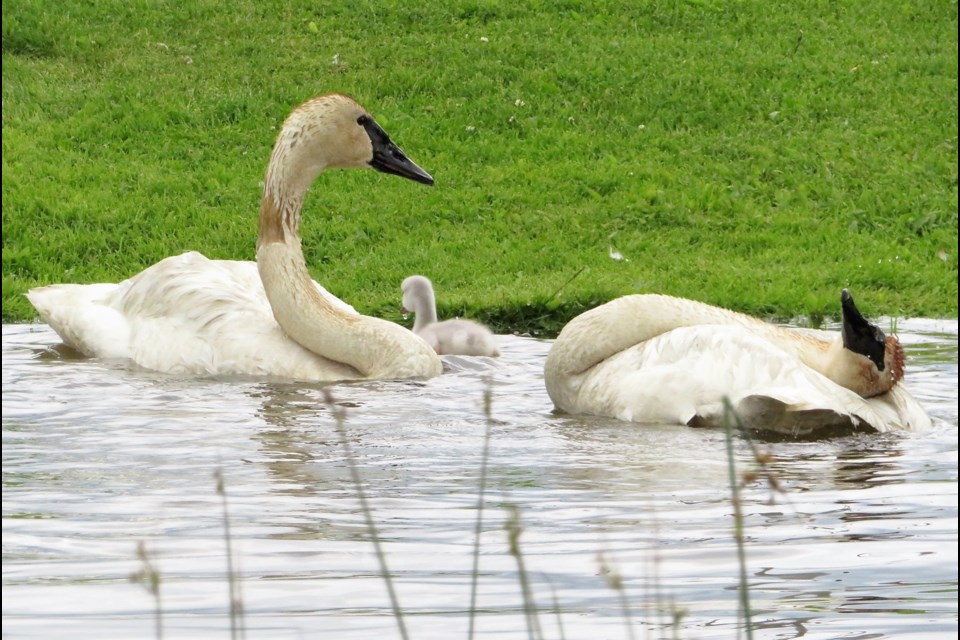A large white mass makes its way through the dense, green pinnacles of cattails. The growth is dense along the narrow water trails that lead through this special kind of foliage. It is a traditional passageway. In spring floods, there is no problem, but now we are in the full swing of summer. Fortunately, there is still a passage for the white forms to penetrate. It is June 30, and there is a special occasion to celebrate if celebrate is what they do.
The large white mass has a much smaller package following closely behind, and behind it another large white form. They make their way towards the open area where there is last year’s newly planted willow from the Sudbury Parks Department that provides shade and a full stretch of green grass.
The forms make their way to the beach head. There are people in the distance on the ball fields and a lady that they are familiar with on the cement seat near the parking lot. Beach head reached, no dogs in the area and up they go, first the leader followed by the small white puff and finally the other adult. “Bigfoot” the dad, “Partner” the mom and the unnamed “puff” have made their presence known. With a smile, the lady takes a picture.
Trumpeter swans have a long legacy in Ontario. They were present long before the white settlers arrived, but over time, became extirpated from the area. Speed ahead several centuries and we arrive at a reintroduction program in the '80s, headed by Harry Lumsden, that eventually took hold in the province through careful protection and monitoring, starting at Wye Marsh.
In 1996 and 1997, several adults were introduced to Kelly Lake for an experiment on feasibility and a migration learning experience like “Home Alone” with ultra-lights. Perhaps it was an unforeseen fact that Greater Sudbury has a unique feature that allowed for the birds to become established year round.
Junction Creek and Fielding Park have open water all year long. It does not freeze in its entirety during the winter. This allowed a resident population of swans to stay long enough to call Sudbury home.
A pair of birds nested in an outlying beaver pond complex close to Lively for many years. In 2016, a nest was established within the city limits in Sudbury. Bigfoot had found a life-long mate and Partner was it. They guarded the four eggs, and Partner sat on the clutch for a very long time. Eventually, the eggs were abandoned as they would not hatch. This year, the news changed. Bigfoot and Partner found a new safe place and it was only when the white “puff” arrived that we realized they were successful.
Like oversized Canada geese, the two trumpeter swans will guard their off spring against threats that may occur during rearing. Loose dogs in parks are always a fear, as well as people getting too close.
In the wild, young cygnets must be wary of mink, otter, raccoons and the like. The bigger the cygnet gets, the safer it becomes. In the fall, the cygnet will look like a dirty white swan with brown-grey plumage and almost full size.
It will still be associated with its parents for much of the winter, but when spring arrives, the parents begin to court and start a new cycle and the young bird goes on its own. Young birds take two or three years to mature and selecting the lifelong mate has many different stories.
Bigfoot is 18 years old, and as far as we know, has selected Partner in only the last two years. Partner is a young swan. Hopefully “puff” will survive the growing stage and become a lifelong member of its species.
Chris Blomme is an executive member of the Sudbury Ornithological Society and works with animals at Laurentian University. Have a question for Chris? Send it to [email protected].
